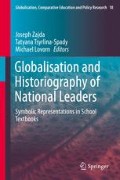Abstract
This chapter analyses the way in which school history textbooks represent the Australian Prime Minister John Curtin, following the outbreak of war with Japan in 1941. It examines the policy change, when Curtin was offering the US to the Australian public as a new source of hope, fostering public resolve, and claiming a leadership role for Australia in Pacific war. Curtin’s leadership at this time has since been considered by many historians as a turning point in Australia’s international relations; for he made explicit that Australia’s plans to draw closer to the US due to the demands of war, was not the end of ties with Britain. Curtin was one of the few leaders who could challenge Winston Churchill and his military policy towards Australia, especially when he asked Churchill for the return of his divisions, fighting Rommel in North Africa to Australia. It is not possible to include every facet or controversy about Curtin’s decision making during World War 2. Historical narratives depicting Curtin’s efforts to pursue Australia’s national interest addresses the hermeneutical challenge of providing sufficient context and guiding questions for students to interpret historical sources in the context of their time and for them to avoid judging Curtin and his decision making from an ahistorical present.
Access this chapter
Tax calculation will be finalised at checkout
Purchases are for personal use only
References
Anderson, B. (1983). Imagined communities reflections on the origin and spread of nationalism. London: Verso.
Ashton, P., & Anderson, M. (2012). History 10: The modern world and Australia. South Yarra: Macmillan.
Board of Senior Secondary School Studies (BOSSSS). (1996). Senior modern history syllabus. Brisbane: Board of Senior Secondary School Studies.
Counsell, C. (2004). Looking through a Josephine-Butler-shaped window: Focusing pupils’ thinking on historical significance. Teaching History, 114, 30–36.
Darlington, R., Jackson, L., & Hawkins, T. (2012). History alive 10 for the Australian curriculum. Milton: Wiley.
Henderson, D., & Zajda, J. (2015). The National Curriculum and History school textbooks in Australia and the Russian Federation. In J. Zajda (Ed.), Globalisation, ideology and politics of education reforms (pp. 25–39). Dordrecht: Springer.
Hennessey, J. (1996). Was 1941 a turning point in Australian foreign policy? In B. Hoepper, D. Henderson, I. Gray, J. Hennessey, & B. Lewis (Eds.), Inquiry 1 – A source-based approach to modern history (pp. 329–402). Brisbane: The Jacaranda Press.
Hudson, W. J., & Stokes, H. J. W. (Eds.). (1982). Documents on Australian Foreign Policy 1937–49 (Vol. 5). Canberra: Australian Government Publishing Service.
Lee, P. (1984). Historical imagination. In A. K. Dickenson, P. J. Lee, & P. J. Rogers (Eds.), Learning history (pp. 84–116). London: Heinemann.
Lee, P., & Ashby, R. (2000). Progression in historical understanding among students ages 7–14. In P. N. Sterns, P. Seixas, & S. Wineburg (Eds.), Knowing, teaching, and learning history: National and international perspectives (pp. 199–222). New York: New York University Press.
Lévesque, S. (2008). Thinking historically: Educating students for the twenty-first century. Toronto: University of Toronto Press.
Manchester, W. (2008). American Caesar: Douglas MacArthur 1880–1964. New York: Back Bay Books/Little, Brown and Company.
Mirams, S., Davidson, M., & Gordon, S. (2006). Imagining Australia: Australian History VCE Units 3 & 4. South Melbourne: Nelson.
Neale, R. G. (Ed.). (1982). Documents on Australian Foreign Policy (Vol. 2). Canberra: Australian Government Publishing Service.
Partington, G. (1980). The idea of an historical education. Windsor: NFER Publishing.
Phillips, R. (2002). Historical significance – The forgotten key concept? Teaching History, 106, 14–19.
Queensland Studies Authority (QSA). (2004). Senior modern history syllabus. Brisbane: Queensland Studies Authority.
Seixas, P. (1996). Conceptualizing the growth of historical understanding. In D. Olson & N. Torrance (Eds.), Handbook of education and human development: New models of learning, teaching, and schooling (pp. 765–783). Oxford: Blackwell.
Seixas, P. (1997). Mapping the terrain of historical significance. Social Education, 61(1), 22–27.
Seixas, P. (2005). Historical consciousness: A scheme of progress in knowledge for a post-progressive age. In J. Straub (Ed.), Narrative, identity and historical consciousness (pp. 141–162). New York: Berghahn Books.
Serle, G. (1993). Curtin, John (1885–1945). In Australian dictionary of biography. Retrieved from http://adb.anu.edu.au/biography/curtin-john-9885
Van Boxtel, C., & Van Drie, J. (2012). ‘That’s in the time of the Romans!’ Knowledge and strategies students use to contextualize historical images and documents. Cognition and Instruction, 30(2), 1–33.
Ward, R. (1988). A nation for a continent: The history of Australia 1901–75. Richmond: Heinemann.
Whitehouse, J. A. (2015a). Historical thinking: A framework for learning and teaching history. Educational Practice and Theory, 37(2), 51–58.
Whitehouse, J. A. (2015b). Blue-water cruising on the high seas of time: What does the Review of the Australian Curriculum mean for senior Ancient History? Curriculum Perspectives, 35(1), 61–63.
Wineburg, S. S. (2001). Historical thinking and other unnatural acts: Charting the future of teaching the past. Philadelphia: Temple University Press.
Zajda, J. (2015a). Globalisation, ideology and history school textbooks: The Russian Federation. In J. Zajda (Ed.), Nation-building and history education in a global culture (pp. 29–50). Dordrecht: Springer.
Zajda, J. (2015b). Globalisation and the politics of education reforms: History education. In J. Zajda (Ed.), Nation-building and history education in a global culture (pp. 1–14). Dordrecht: Springer.
Zajda, J. (2016). Globalisation, national identity and the politics of history textbooks. Dordrecht: Springer.
Author information
Authors and Affiliations
Corresponding author
Editor information
Editors and Affiliations
Rights and permissions
Copyright information
© 2017 Springer Science+Business Media Dordrecht
About this chapter
Cite this chapter
Henderson, D., Whitehouse, J., Zajda, J. (2017). The Portrayal of John Curtin as Australia’s War Time Labor Prime Minister. In: Zajda, J., Tsyrlina-Spady, T., Lovorn, M. (eds) Globalisation and Historiography of National Leaders. Globalisation, Comparative Education and Policy Research, vol 18. Springer, Dordrecht. https://doi.org/10.1007/978-94-024-0975-8_16
Download citation
DOI: https://doi.org/10.1007/978-94-024-0975-8_16
Published:
Publisher Name: Springer, Dordrecht
Print ISBN: 978-94-024-0974-1
Online ISBN: 978-94-024-0975-8
eBook Packages: EducationEducation (R0)

